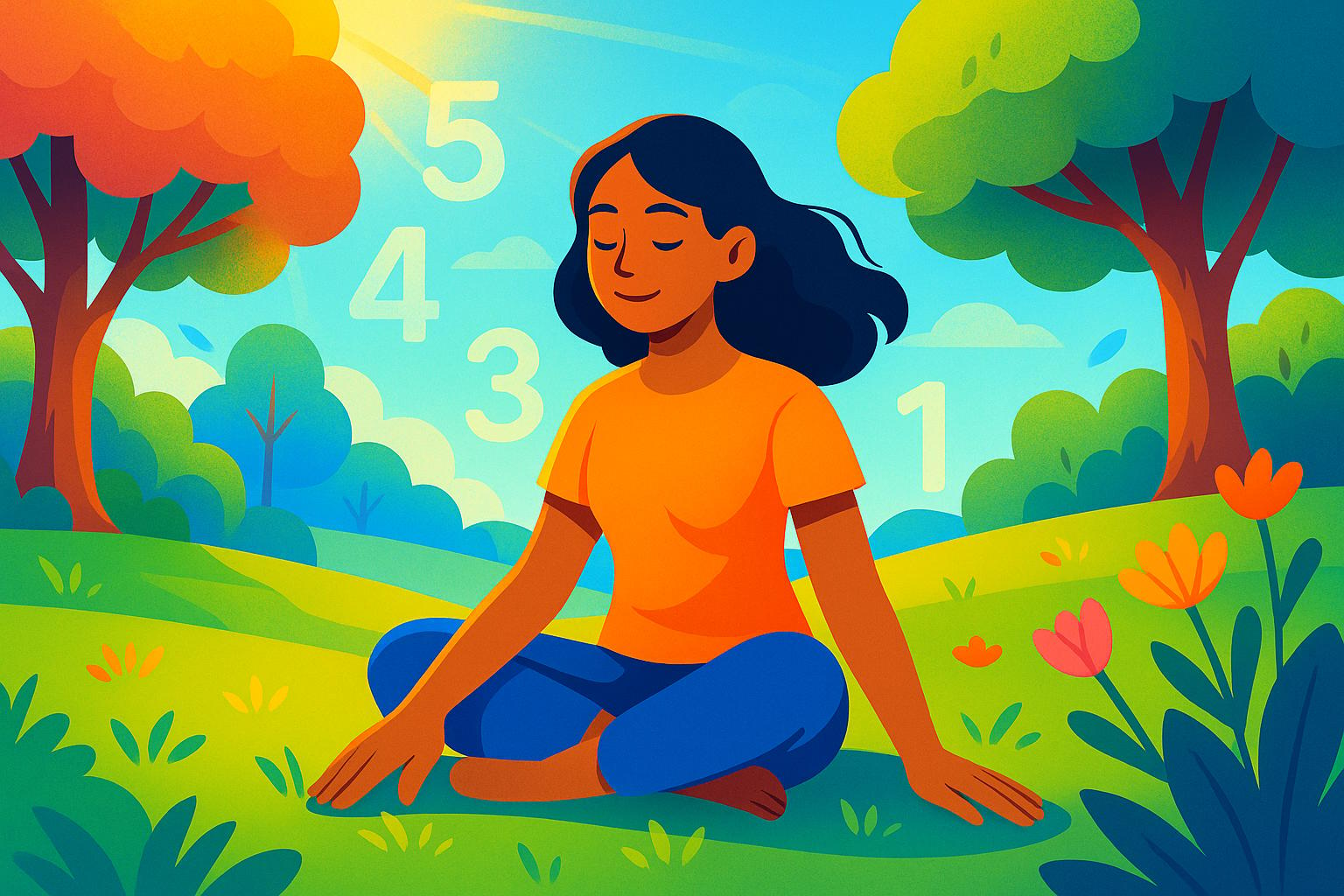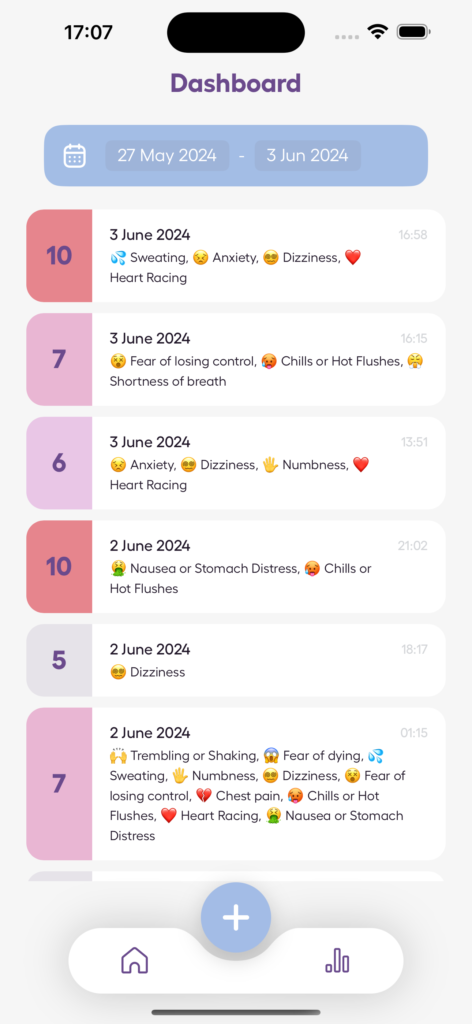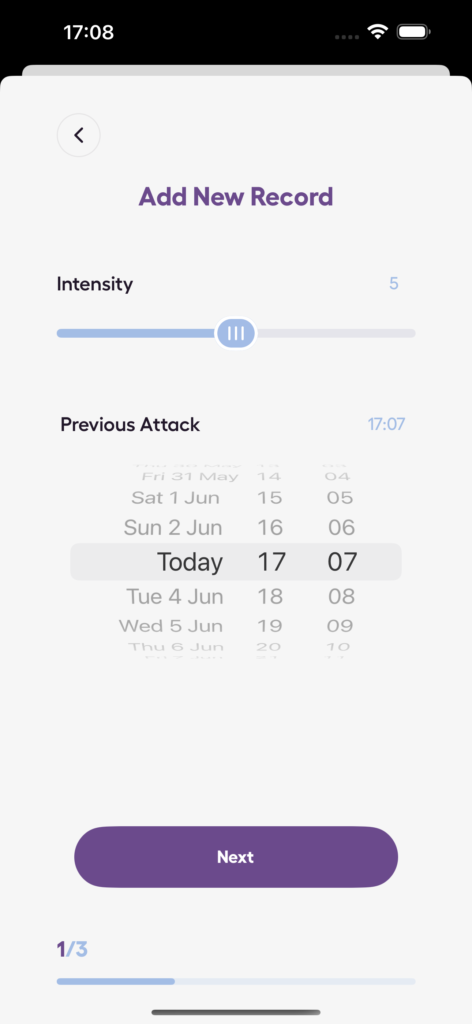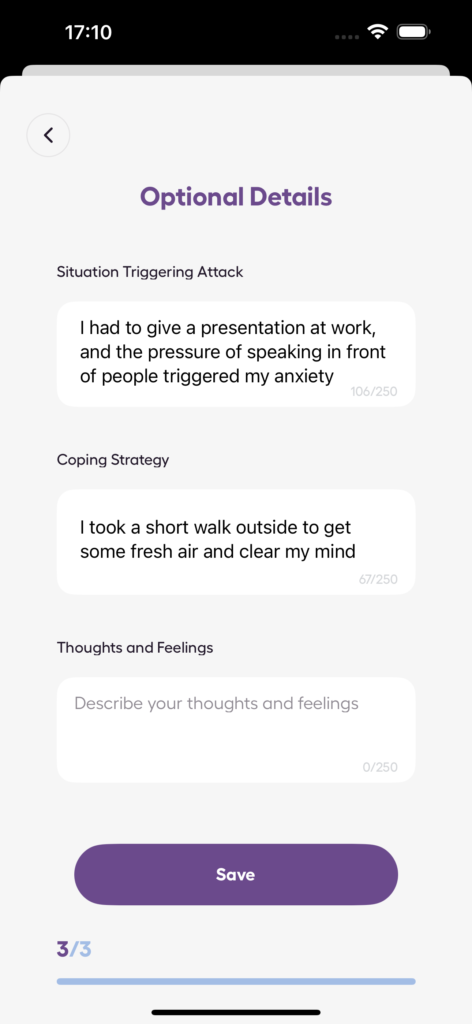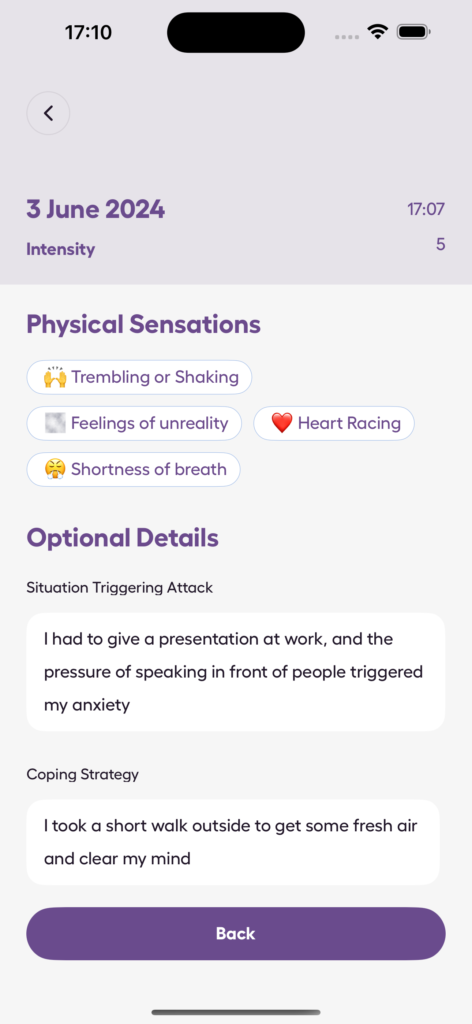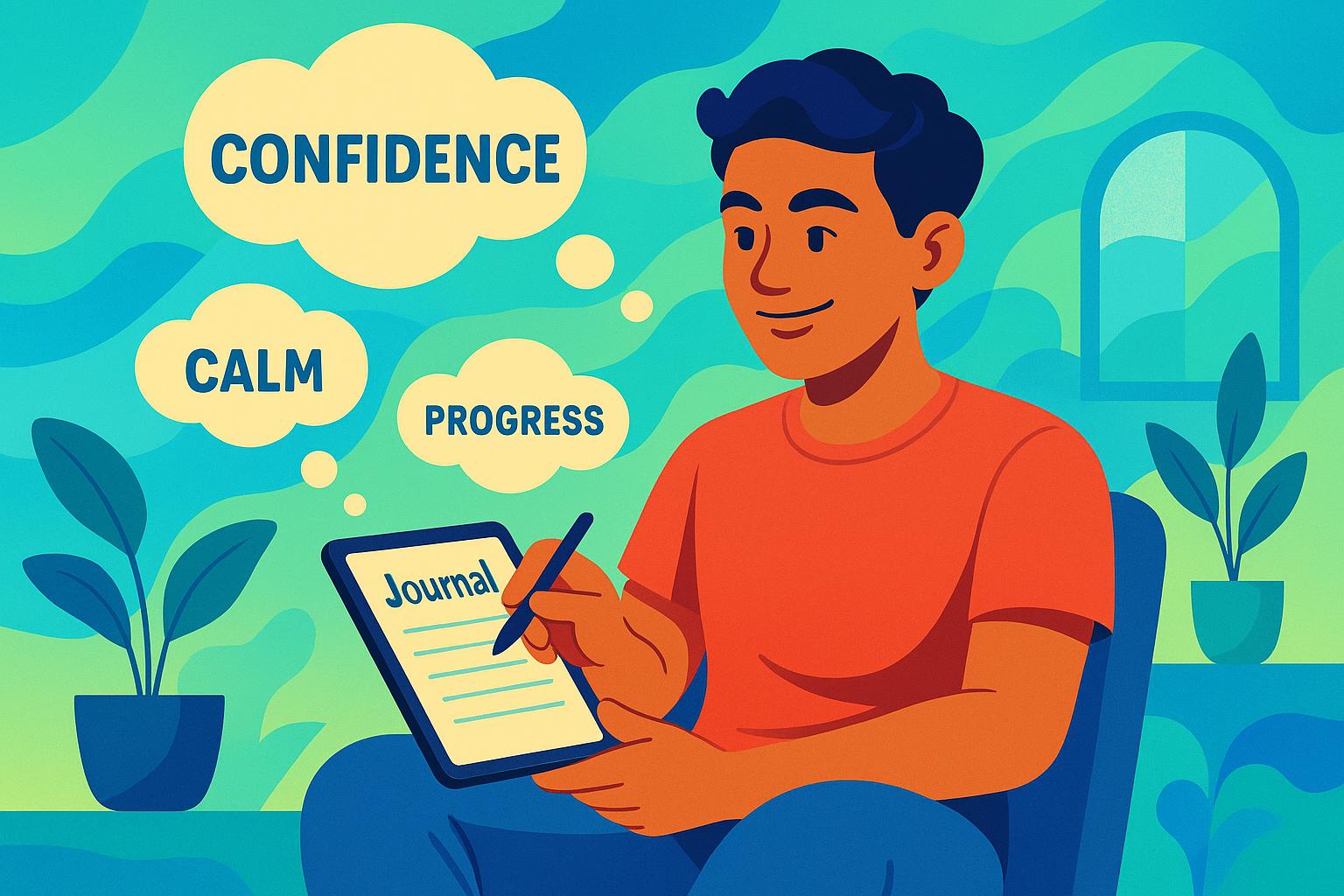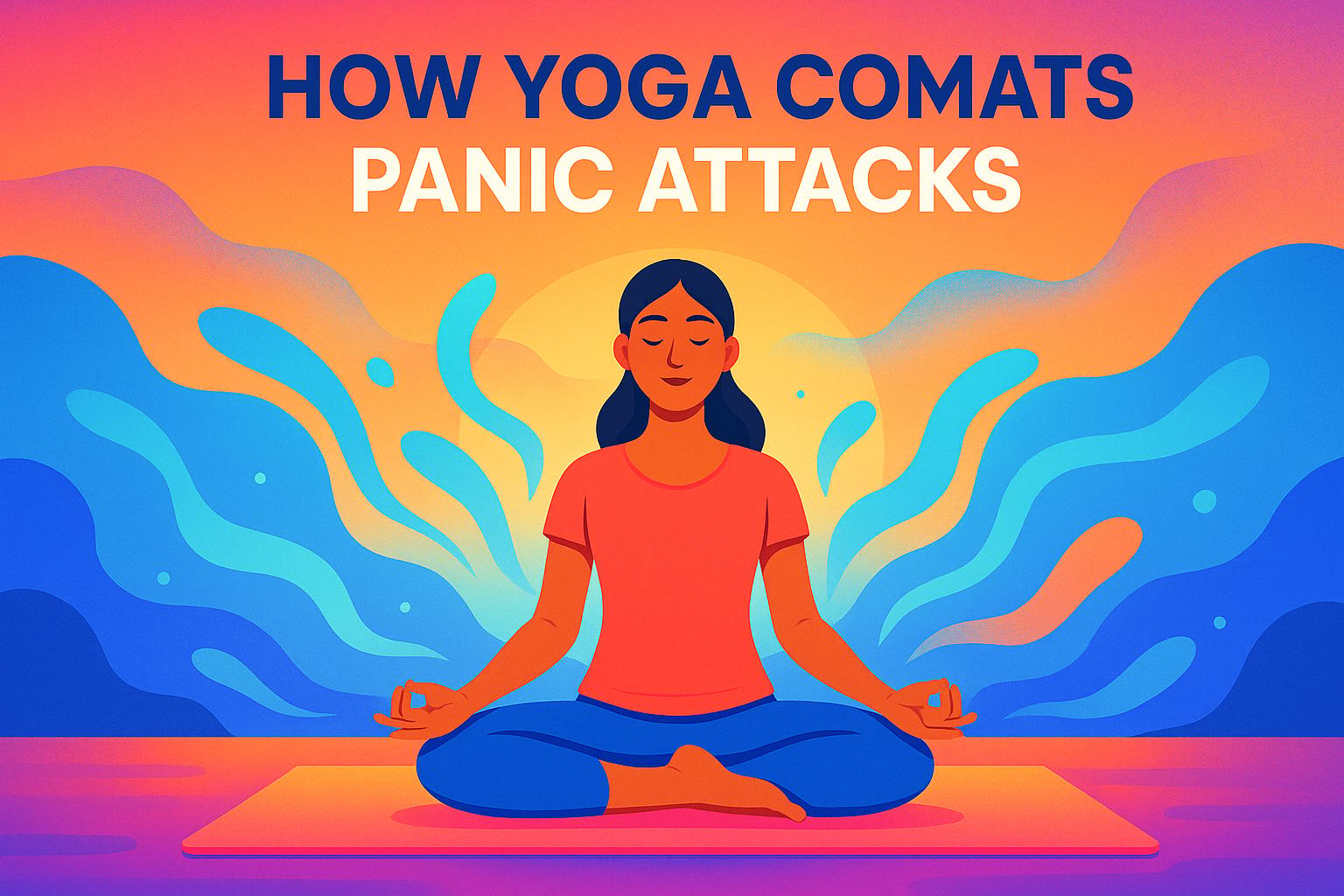Grounding techniques are simple tools to manage anxiety by focusing on the present moment. They use your senses to break cycles of anxious thoughts and calm your mind. One effective method is the 5-4-3-2-1 technique, which engages sight, touch, hearing, smell, and taste to bring your attention back to reality. You can practice these techniques anywhere, whether you’re dealing with a panic attack, preparing for a stressful event, or calming your mind before bed.
Key Points:
- What are grounding techniques? Tools to shift focus from anxiety to the present moment using senses.
- Why do they work? They interrupt stress responses and help regain control.
- Popular method: The 5-4-3-2-1 technique:
- 5 things you see
- 4 things you touch
- 3 things you hear
- 2 things you smell
- 1 thing you taste
- When to use them: During anxiety, before stressful events, or as part of a daily routine.
- Other options: Physical (e.g., holding an ice cube), mental (e.g., counting backward), and soothing techniques (e.g., imagining a comforting place).
Grounding techniques are practical, easy to learn, and can be personalized to suit different situations. Start small, practice regularly, and track what works best for you.
The 5-4-3-2-1 Method: A Grounding Exercise to Manage Anxiety
The 5-4-3-2-1 Method Explained
The 5-4-3-2-1 method is a simple mindfulness exercise that uses your five senses to ground you in the present moment, especially during times of anxiety.
"A mindfulness exercise, this technique helps us come out of anxiety, unpleasant thoughts, or worries and come into what is right here, right now in the present, through our senses."
- Stephanie Strauss, yoga, meditation, and mindfulness expert
What makes this technique so effective is how easy it is to use. You don’t need any special tools or prior training, and it can be practiced anywhere, anytime. Here’s how each step works to bring your focus back to the here and now.
How Each Step Works
The method involves counting down and actively engaging your senses:
- 5 things you can see: Look around and name five items in your environment – perhaps a clock on the wall, a book on the table, or the way sunlight filters through a window.
- 4 things you can touch: Notice the textures around you. It could be the fabric of your clothes, the smooth surface of your phone, or even the ground beneath your feet.
- 3 things you can hear: Tune in to the sounds around you. These might include distant traffic, birds chirping, or the sound of your own breathing.
- 2 things you can smell: Identify two scents nearby, like the aroma of coffee, a scented candle, or even the fresh air.
- 1 thing you can taste: Focus on one taste – this could be the remnants of a meal, a sip of water, or simply the neutral taste in your mouth.
This step-by-step process shifts your attention away from anxious thoughts and helps re-center your mind. By anchoring yourself in sensory experiences, you’re giving your brain a chance to relax and reset.
Why This Method Helps Your Brain
When anxiety strikes, the mind often spirals into worry and overthinking. Engaging your senses with the 5-4-3-2-1 method interrupts this cycle and redirects your focus. This sensory engagement activates neural pathways tied to awareness and attention. It also stimulates the parasympathetic nervous system, which helps your body relax and counteracts the effects of stress. Studies have shown that mindfulness practices like this one can reduce anxiety and depression while boosting overall happiness.
Best Times to Use 5-4-3-2-1
The beauty of this method is its flexibility – you can use it in a variety of situations to regain composure and focus:
- During moments of anxiety: If you feel a panic attack coming on, this exercise can help ground you in the moment.
- Before stressful events: Calm your nerves before a big meeting, presentation, or interview by practicing this technique.
- When overwhelmed: Whether you’re juggling a packed schedule or feeling pulled in multiple directions, this method can bring clarity.
- To manage strong emotions: It’s also helpful for diffusing feelings of anger, sadness, or frustration.
- In everyday situations: Use it during mundane moments, like waiting in line or sitting in traffic, to ease agitation.
- As a bedtime ritual: Incorporate it into your nighttime routine to relax and prepare for sleep.
"This technique can empower us to take an active role in managing our anxiety and stress levels, giving us a sense of control and self-efficacy."
- Steph Strauss, Mindfulness Expert
How to Practice Grounding Techniques for Anxiety
Mastering grounding techniques can be a game-changer when anxiety strikes. The trick lies in knowing the steps and having a few go-to methods ready when you need them most.
Step-by-Step 5-4-3-2-1 Instructions
The 5-4-3-2-1 method is a simple yet powerful way to redirect your focus. The key is to take your time with each step – rushing through won’t give your mind enough space to shift away from anxious thoughts.
Step 1: See (5 things)
Take a moment to look around and identify five things you can see. Pay attention to the details of each item – their colors, shapes, or textures.
Step 2: Touch (4 things)
Notice four things you can physically feel. This might be the softness of your sweater, the cool surface of a table, or the ground beneath your feet. Close your eyes if it helps you focus more on the sensation.
Step 3: Hear (3 things)
Listen for three distinct sounds in your environment. It could be the hum of a fan, the chirping of birds, or distant traffic. Tune into sounds you might often overlook.
Step 4: Smell (2 things)
Identify two scents around you. If you can’t detect any smells, try focusing on another sense or recall a favorite scent from memory.
Step 5: Taste (1 thing)
Notice one thing you can taste. It might be gum, the lingering flavor of a drink, or simply the natural taste in your mouth. If you’re unsure, imagine the taste of a favorite food.
Once you complete all five steps, take a deep breath and check in with yourself. Notice if there’s been any shift in how you feel. Repeat the exercise as needed, experimenting with different sensations each time.
If you’re looking for more ways to ground yourself, consider the additional techniques below.
Other Grounding Methods
The 5-4-3-2-1 method works well, but having a few alternatives can be helpful for different situations.
Physical grounding techniques focus on using your body to stay present. For example, you could run your hands under cool or warm water, hold an ice cube and notice how it melts, or take a short walk while paying attention to how your feet feel with each step.
Mental grounding techniques keep your mind busy with simple tasks. Try studying a detailed picture, then close your eyes and recreate it from memory. You can also list items in a category, like types of flowers or cities you’ve visited, count backward from 100, or recite a favorite poem or song lyric.
Soothing grounding techniques aim to bring comfort. Imagine the face or voice of someone you love, repeat kind words to yourself, or hold onto a comforting object, like a soft blanket or a piece of jewelry. If you have a pet, spend a moment stroking their fur. You might also picture your favorite place – what does it look, sound, and smell like?
"It helps bring you back into your body… I think when people are in pain or very anxious or stressed, they tend to disconnect a little bit from their physical bodies." – Melissa Young, MD, Functional Medicine Specialist
Solving Common Problems
While grounding techniques are effective, you might run into a few challenges. Here’s how to handle them:
Difficulty focusing:
If anxious thoughts keep creeping in, stick with the technique for a bit longer before trying something else. A little persistence often helps your mind shift gears.
Sensory limitations:
If one of your senses isn’t giving you much input – like if you’re in a quiet space or have limited vision – lean on others, such as touch or smell. Adjust the exercise to suit your environment.
Anxiety in public spaces:
Feeling self-conscious in public? Many grounding techniques are subtle. For instance, you can focus on the texture of your clothing, tap your fingers discreetly, or listen to background sounds without drawing attention.
Inconsistent results:
Not every technique will work the same way every time, and that’s okay. Try rating your anxiety on a scale of 1 to 10 before and after each exercise to see what’s most effective for you. Some methods might work better for mild anxiety, while others help during more intense moments.
"It’s more a matter of personal preference. I’m always encouraging people to try different techniques because there’s so many options and, really, some resonate with some people more, and less so with others." – Melissa Young, MD, Functional Medicine Specialist
sbb-itb-b1dedcc
Grounding Techniques Comparison
This section builds on the earlier discussion of grounding exercises by comparing common methods to help you find the one that suits your needs best.
Grounding Methods Side-by-Side
Each grounding technique offers specific benefits and works well in different situations. Here’s a breakdown of how they compare:
| Technique | Ease of Use | Best For | Time Needed | Environment |
|---|---|---|---|---|
| 5-4-3-2-1 Method | Very Easy | Panic attacks, overwhelming anxiety | 3–5 minutes | Any location, no tools needed |
| Deep Breathing | Easy | Daily stress, mild anxiety | 2–3 minutes | Quiet spaces preferred |
| Physical Grounding | Moderate | Immediate relief or dissociation | 1–5 minutes | Access to objects or water needed |
| Mental Grounding | Moderate | Racing thoughts, worry spirals | 5–10 minutes | Requires focus and concentration |
| Soothing Techniques | Easy | Emotional distress, trauma responses | 5–15 minutes | Private, comfortable space |
The 5-4-3-2-1 method stands out for its simplicity and versatility. It doesn’t require any tools and can be done anywhere, making it ideal for moments of acute anxiety or panic attacks. On the other hand, physical grounding techniques – like holding an ice cube or running cool water over your hands – can provide immediate sensory relief by redirecting your focus. Meanwhile, soothing techniques emphasize self-compassion and comfort, offering a gentle way to manage emotional distress.
"Grounding techniques are incredibly helpful tools for managing panic attacks, anxiety, and addiction… a lifeline during moments of intense stress and can help individuals regain a sense of stability and composure in the midst of chaos."
– Adam Siegel, Lead Addiction Therapist, Olympic Behavioral Health
Picking the Right Method for You
The table above highlights the unique strengths of each technique, helping you decide which one to use when anxiety strikes. Tailoring your approach to your specific triggers, symptoms, and surroundings can make a big difference.
For instance, panic attacks or acute anxiety often respond well to physical grounding methods or the 5-4-3-2-1 technique, which interrupts the body’s panic response and helps you regain a sense of safety. In contrast, mental grounding and soothing techniques are better suited for managing everyday stress or calming racing thoughts over a longer period.
Your sensory preferences also play an important role. Some people find tactile inputs, like holding an object, more grounding, while others respond better to visual or auditory cues. If certain senses feel overstimulated during anxiety, adapt the techniques to focus on what feels most calming for you.
The setting matters, too. In public, the discreet 5-4-3-2-1 method is a great option, while physical techniques might require access to specific items or water. Soothing strategies, on the other hand, work best in private, comfortable spaces where you can fully relax.
To refine your approach, consider keeping a journal. Note when and where your anxiety occurs, what might have triggered it, and which grounding method you used. Tracking your distress levels before and after each session can help you identify which techniques are most effective for you.
Finally, practice regularly – even when you’re not feeling anxious. Familiarity with these techniques ensures they’re ready to use when you need them most. Experiment with different methods, and over time, you’ll develop a reliable toolkit tailored to your needs.
Making Grounding Part of Your Daily Routine
Incorporating grounding techniques into your daily life can make them second nature, helping you manage anxiety more effectively when it arises. By turning these techniques into regular habits, you’ll be better prepared to handle stressful moments.
Creating a Daily Practice
Integrate grounding into your everyday activities. For example, during your morning shower or a quick break at work, you can try the 5-4-3-2-1 method to focus on physical sensations.
On particularly stressful days, combining techniques can make a big difference. A nature walk paired with deep breathing and calming music can provide a multisensory way to center yourself. You can also explore other options like listening to soothing sounds, splashing cold water on your face, or giving yourself a comforting hug to create a personalized set of tools.
Once grounding becomes part of your routine, it’s helpful to monitor how these techniques are working for you.
Tracking Your Progress
Keep tabs on your anxiety levels by rating your distress on a scale from 1 to 10 before and after using a grounding technique. This simple practice allows you to recognize patterns and apply techniques early when you sense anxiety building.
For a more structured approach, you might find tools like the Anxiety Journal app useful. This app helps you log panic attacks, track anxiety levels, record the techniques you’ve tried, and monitor your progress – all in one secure and private space.
Staying Consistent and Patient
The key to success is consistency. Regular practice helps these techniques become second nature. Even on days when you’re feeling calm, dedicating a few minutes to grounding exercises strengthens your ability to cope during tougher times.
Patience is equally important. It takes time to master these skills, so stick with it. Use grounding techniques until your distress eases, and don’t hesitate to experiment with different methods to find what works best in various situations.
With steady practice, you’ll build a reliable toolkit that boosts your confidence in managing anxiety whenever it arises.
Key Points for Managing Anxiety
Grounding techniques help bring your focus back to the present moment, offering practical ways to manage anxiety while building mental strength for the long haul.
Main Benefits of Grounding
Grounding techniques work by activating your body’s natural relaxation response, calming the sympathetic nervous system – the part responsible for the fight-or-flight mode that kicks in during anxious moments. These techniques don’t just ease anxiety; they also improve overall mental health and related symptoms.
Jamie Hanley, MS, LPC, a therapist with Lyra Health, puts it this way:
"These practices are especially helpful for anxiety because they address the body’s fight, flight, freeze, or fawn response".
By tuning into your senses and focusing on what’s happening right now, grounding helps you keep emotions in check and prevents negative feelings from spiraling out of control. Over time, this ability to regulate emotions builds resilience, making it easier to handle life’s ups and downs.
Practicing grounding regularly also strengthens neural pathways that support healthier coping mechanisms. Research backs its effectiveness for improving mental health. Plus, it can help you quickly return to the present when troubling thoughts arise.
The best part? Starting is straightforward and accessible.
Getting Started Today
The beauty of grounding techniques lies in their simplicity. You don’t need fancy tools, formal training, or a big time commitment to get started. Practicing a little each day helps you become comfortable with these methods so they’re ready when you need them most.
A great starting point is the 5-4-3-2-1 method, which engages your senses to anchor you in the moment. Once you’ve got that down, try experimenting with other strategies to find what suits you best. Timing is key – use grounding techniques as soon as you feel anxiety creeping in, rather than waiting until it becomes overwhelming.
For extra support, consider using tools like the Anxiety Journal app to track your progress and stay consistent.
As Jamie Hanley reminds us:
"Emotions are temporary, and learning techniques like grounding exercises can provide life-changing support in navigating anxiety".
Every grounding session you practice adds to your personal toolkit, giving you reliable ways to regain calm and clarity whenever you need it most.
FAQs
What are some effective ways to use grounding techniques daily to manage anxiety?
Grounding techniques are an effective way to manage anxiety, especially when practiced consistently. One popular approach is the 5-4-3-2-1 method, which uses your senses to anchor you in the present moment. Here’s how it works: notice five things you can see, four things you can touch, three things you can hear, two things you can smell, and one thing you can taste. This simple exercise can help calm your mind during stressful moments by shifting your focus.
To make grounding part of your daily routine, dedicate a few minutes each day to mindfulness exercises. This could include deep breathing or simply paying close attention to your surroundings. Regular practice not only helps you stay present but can also reduce the intensity of anxiety triggers over time. The more consistently you practice, the more effective these techniques become in building resilience and managing anxiety.
What can I do if I struggle to use the 5-4-3-2-1 technique during a panic attack?
If the 5-4-3-2-1 technique feels like too much to handle during a panic attack, there are other ways to ground yourself that might feel more manageable. Start by focusing on your breath – take slow, deep breaths in and out. Or, shift your attention to the feeling of your feet pressing against the ground. Even small movements, like wiggling your toes or gently shifting your weight, can help bring you back to the present.
Distraction can also be a powerful tool. Try holding onto something comforting, like a soft blanket or a favorite object. Listening to soothing sounds or quietly repeating a calming phrase to yourself can also help. These methods can give you a sense of stability until you’re ready to try the 5-4-3-2-1 technique again or explore another grounding exercise that feels right for you.
Are there situations where grounding techniques might not work as well or need adjustments?
Grounding techniques might not work as well in loud or chaotic environments, like bustling public spaces or noisy crowds. These settings can make it tough to focus on the sensory cues grounding relies on. Similarly, for someone in the middle of a severe anxiety episode or a panic attack, it can be challenging to concentrate enough to use these methods effectively.
To make grounding techniques more useful, try practicing them in quieter, more private spaces first. With regular practice, they can become second nature and easier to apply in tougher situations. If needed, seeking personalized strategies or professional guidance can provide extra support.
